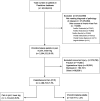DEMOGRAPHIC AND EPIDEMIOLOGICAL TRENDS IN PATELLOFEMORAL PAIN
- PMID: 26075143
- PMCID: PMC4458915
DEMOGRAPHIC AND EPIDEMIOLOGICAL TRENDS IN PATELLOFEMORAL PAIN
Abstract
Background: Understanding the demographics of patellofemoral pain is important to determine the best practices in diagnosis and treatment of this difficult pathology. The occurrence of patellofemoral pain has been reported from isolated sports medicine clinics and from within the military, but its incidence has never been examined in the general population within the United States.
Purpose: The purpose of this study was to examine the reported occurrence of patellofemoral pain for those individuals seeking medical care and to compare that to all other pathologies that result in anterior knee pain, such as tendinopathies, patella subluxation, osteoarthritis, or meniscal and bursal conditions. Occurrence rates were examined across sex, age and region within a large healthcare provider database that contains over 30 million individuals.
Methods: Data were queried with the PearlDiver Patient Record Database, a national database containing orthopedic patient records. Two common International Classification of Disease, Ninth Revision (ICD-9) codes for patellofemoral pain (717.7 - Patella Chondromalacia and 719.46 - Pain in joint, lower leg) were utilized and were searched from the years 2007-2011. The top twenty additional ICD-9 codes that were concurrently coded with 717.7 and 719.46 were removed from the data. Chi-squared and Mantel-Haenszel tests were utilized to identify statistically significant differences in the diagnosis of patellofemoral pain between sex, age, and year.
Results: During this five-year period, there were 2,188,753 individuals diagnosed with patellofemoral pain. The diagnosis was more common in females compared to males with 1,211,665 and 977,088 cases respectfully (p<0.001). Statistically significant differences between ages was found, with 50-59 year olds having the most cases with 578,854, p<0.001. And, during the five-year examination period, there was a steady increase between 2007-2011, p<0.01.
Conclusion: Patellofemoral pain was diagnosed between 1.5% and 7.3% of all patients seeking medical care within the United States. Females experienced patellofemoral pain more often than males and there was a steady increase of cases in the United States during the 2007-2011 examination period. The diagnosis of patellofemoral pain increased with age and the 50-59 year old age group had the most cases.
Level of evidence: 2b.
Keywords: Anterior knee pain; chondromalacia; epidemiology.
Figures
References
-
- Crossley K Bennell K Green S McConnell J. A systematic review of physical interventions for patellofemoral pain syndrome. Clin J Sport Med. 2001;11(2):103‐110. - PubMed
-
- Davis IS Powers CM. Patellofemoral pain syndrome: Proximal, distal, and local factors, an international retreat, April 30‐May 2, 2009, Fells Point, Baltimore, MD. J Orthop Sports Phys Ther. 2010;40(3):A1‐16. - PubMed
-
- Duffey MJ Martin DF Cannon DW Craven T Messier SP. Etiologic factors associated with anterior knee pain in distance runners. Med Sci Sports Exerc. 2000;32(11):1825‐1832. - PubMed
LinkOut - more resources
Full Text Sources
Medical
Research Materials




